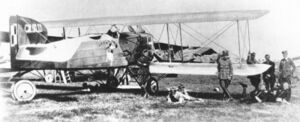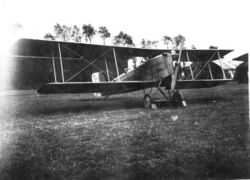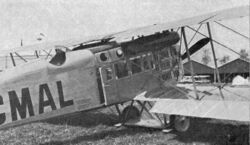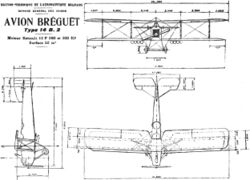Engineering:Breguet 14
| Breguet 14 | |
|---|---|

| |
| Polish Breguet 14 during the Kiev Offensive | |
| Role | Bomber |
| Manufacturer | Breguet |
| Designer | Marcel Vuillierme |
| First flight | 21 November 1916 |
| Introduction | 1917 |
| Primary users | Aéronautique Militaire US Army Air Service Polish Air Force Royal Thai Air Force |
| Produced | 1916-1928 |
| Number built | ca 8,000[1] |
The Breguet 14 was a French biplane bomber and reconnaissance aircraft of the First World War. It was built in very large numbers and production continued for many years after the end of the war.
Apart from its widespread usage, the Breguet 14 is known for being the first mass-produced aircraft to use large amounts of metal, rather than wood, in its structure. This allowed the airframe to be lighter than a wooden airframe of the same strength, in turn making the aircraft relatively fast and agile for its size; in combat situations, it was able to outrun many of the contemporary fighters of the day. The Breguet 14's strong construction allowed it to sustain considerable damage, in addition to being easy to handle and possessing favourable performance. The type has often been considered to have been one of the best aircraft of the war.
Development
Background
The Breguet 14 was designed by aviation pioneer and aeronautical engineer Louis Breguet.[2] By this point, Breguet's company had already built up a reputation for producing several capable aircraft and advanced aerodynamic test apparatus, including the Breguet-Richet Gyroplane, which held the distinction of being the first direct-lift aircraft in the world. Breguet had been a key innovator in the field of all-metal construction, which he had employed on a successful series of biplanes during the pre-war years; these principal would be applied in the designing of the Breguet 14 as well.[3]
The outbreak of the First World War in 1914 quickly led to large numbers of Breguet-built aircraft being inducted into the military air services of several nations, including many of the nations in the Triple Entente.[4] Breguet himself flew as a military pilot early on in the war, and soon recognised there was demand for aircraft fitted with more powerful engines in order to carry worthwhile payloads over anything beyond short distances. For his next design, he opted to abandon his previously-favoured tractor configuration in favour of a pusher configuration to better satisfy the inflexible requirements issued by the French general staff, which sought an unobstructed frontal viewpoint to benefit the observer.[4]
During the summer of 1915, the French Ministry of War held a competition, seeking to determine the most suitable type of aircraft to carry a bombload of 300 lb at a speed of 120 km/h over a minimum distance of 600 km.[4] Following an extensive evaluation, Breguet's submission to the contest, SN-3; reportedly, a major reason for its selection over more powerful rivals was its use of the desired pusher configuration. The SN-3 would be developed into the Breguet Type IV, V, and VI, which would be built in large quantities for military use.[4]
Origins
In spite of the expressed preference of French officials for the pusher configuration, Breguet remained a proponent of tractor aircraft.[5] During June 1916, he decided to initiate work on a clean-sheet design for a military-oriented two-seater aircraft, which was assigned the designation of Breguet AV Type XIV. According to aviation authors J.M Bruce and Jean Noel, the French Army's Section Technique de l' Aéronautique (S.T.Aé.) received early information on the design and recommended that Breguet power it using a 200 hp engine by Hispano-Suiza.[6] However, Breguet found that the engine would be incapable of delivered the desired performance, instead insisting on the adoption of a 12-cylinder Renault-built engine that had been powered the previous Breguet Type V.[6]
The Breguet Type XIV was both a practical and aesthetically pleasing design.[6] A distinctive characteristic of the Type XIV was its rectangular frontal radiator, as well as the shape of is cowling and the negative-stagger of its mainplanes.[6] It possessed a sturdy undercarriage, along with two-part ailerons on the upper wing only. On the prototype, the lower wing reportedly featured flaps along the trailing edges, that partly emulated the manner of operation of "single-acting ailerons" in only "coming up" from their "down" position at rest, as the aircraft accelerated during takeoff; these possessed a limited angle of depression and were not directly controlled by the pilot, instead being actuated by a set of 12 adjustable rubber bungee cords.[7]
The airframe was composed primarily of duralumin, invented in Germany by one Alfred Wilm a decade earlier; many sections, such as the duralumin longerons and spacers, were attached using welded steel-tube fittings and braced using piano wire. The wing's main spar were rectangular duralumin tubes complete with either oak or ash lining-pieces at the attachment points and sheet steel sheaths around the spars.[6] The box-unit wooden ribs had fretted plywood webs and ash flanges. The surfaces of the tail unit used welded steel tube structures; while the elevators featured horn balances.[6] During its design phase, French officials were wary of the Type XIV's structure, having made such an extensive use of the relatively new metal duralumin that it was claimed to be the first aircraft in the world to combine heavy use of the metal with oxy-welded joints.[8]
Into flight
On 21 November 1916, the first prototype conducted its maiden flight, flown by Breguet himself.[8] The first flight had confirmed Breguet's opinion that the Renault engine was more suitable for the type; on 30 November 1916, he informed the S.T.Aé of this determination and of the comparably worse performance of their recommended engine.[8] On 11 January 1917, Breguet informed the S.T.Aé that the prototype had reached the point where he considered it to be representative of production-standard aircraft. Later that month, it participated in further trials and, by 7 February 1917, the S.T.Aé had issued a report, declaring that the prototype had attained an air speed of 172 km/h at an altitude of 2,000 meters.[8]
During November 1916, the S.T.Aé. had issued its requirements for four different new aircraft types. Breguet submitted his new design for two of those categories - reconnaissance aircraft, and bomber. Following its evaluation during February 1917, the Breguet 14 had been accepted to perform both of these roles. On 22 February 1917, Breguet pressed the S.T.Aé for a production order to be issued for the type; on 2 March, he declared that production jigs had been prepared for quantity production of the type.[8] On 6 March 1917, the first official production order was received by Breguet, calling 150 aircraft, designated as the Breguet 14 A.2; a follow-on order for a further 100 aircraft was received on 4 April.[8]
Mass production and further development
By March 1917, several orders had been placed, calling for a combined 150 reconnaissance aircraft and 100 bombers, designated "Breguet 14 A.2" and "14 B.2" respectively (by 1918, it was written as Breguet XIV A2/B2). The A.2 variant was equipped with an array of cameras, while some were also provisioned with radios, while the lower wing of the 14 B.2 was modified slightly in order to accommodate bomb racks (built by Michelin), capable of housing up to 32 115 mm calibre bombs.[9] To avoid the bomb racks conflicting with operation of the flaps, a small forward extension of the wings was added; another modification was the installation of transparent panels to the sides of the observer's cockpit to aid in the operation of the bomb sight.[9]
By mid-1917, French authorities had expressed a high level of confidence in the type in the form of a substantial expansion of the type's production.[10] Various other companies were contracted to manufacture the type.[8] On 25 April, French aviation company Darracq was requested to manufacture 330 aircraft. On 8 June, another 50 were ordered from Société des avions Henri & Maurice Farman; on 18 June, Paul Schmitt was issued a contract to produce 200 aircraft.[8] Some of the contractors were unable to commence quantity production of the Breguet 14 until 1918.[9] Following the war, a handful of aircraft were constructed in French military-owned workshops in Indo-China, albeit these are likely to have been heavily reliant upon the availability of spare parts.[11]
As an insurance against engine shortages, alternative engines to use in place of the standard Renault powerplant were fitted on some aircraft, both for experimental purposes and in production quantities.[12] An improved model of the standard engine, referred to as the Reanault 12Ff, appeared in Summer 1918 and was used on some later-built aircraft.[12] Another engine adopted was built by French automotive company Lorraine-Dietrich, which was lighter but produced less power than the Renault unit. A number of Belgian and United States Breguet 14s were outfitted with the Fiat A.12 engine.[13] A number of later-built B2 models were equipped with the U.S.-built Liberty engine; to distinguish these aircraft, they were denoted as the Breguet 14 B2 Ls.[14]
Other minor variants of the Breguet 14 were flown in small numbers during the Great War; these included the 14 B.1 long-range single-seat bomber, the 14 GR.2 long-range reconnaissance, the 14 H floatplane, the 14 S air ambulance and the 14 Et.2 trainer.[15] Later variants, such as the 14bis A2 and 14bis B2, featured improved wings. An improved variant equipped with enlarged wings was produced as the 16. Further derivatives of the aircraft included the two-seat fighter 17, which would only be built in small numbers due to its late arrival.[12] Production of the base Breguet 14 continued long after the end of the war, finally ending in 1926.[11]
Operational history
The Breguet 14 was taken on in quantity by the French Air Force. At its peak, the type equipped at least 71 escadrilles of the service, and was deployed on the Western Front, where it participated in number major actions in which it typically acquitted itself as a capable platform.[9] For its actions during the Battle of the Lys, the Section Artillerie Lourde, equipped with the type, received a citation for its activity, and was further lauded for its actions during the subsequent Allied counterattack to the German's Spring Offensive. Om 9 July 1918, Capitaine Paul-Louise Weiller shot down two enemy aircraft during a single sortie flying the type.[9] Both the 14A2 and 14B2 were heavily used in the conflict and were subject to considerable modification during the conflict, particularly to respond to increasing German opposition to Allied Air operations.[16]
Following its successful deployment by the French, during 1918, the Breguet 14 was also ordered in quantity by the Belgian Army (40 aircraft) and the United States Army Air Service (over 600 aircraft).[17] Around half the Belgian and U.S. aircraft were fitted with Fiat A.12 engines due to shortages of the original Renault 12F. Prior to the Armistice of 11 November 1918, which effectively ended the First World War, the Breguet 14 was typically assigned to serve in both reconnaissance and bombing roles. By the end of the conflict, the type had reportedly been responsible for dropping a combined total of 1,887,600 kg (or 1,854 tons) of bombs.[18]
In one of its more atypical deployments, a Breguet 14 played a role in one of the last actions of the war. During November 1918, the aircraft was used to transport a German military officer, Major von Geyer, from Tergnier and Spa; it was covered in larger white flags of truce to avoid being engaged.[18]
The type continued to be widely used after the war, equipping the French occupation forces in Germany and being deployed to support French troops in the colonies.[11] A special version was developed for the harsh conditions encountered overseas, designated "14 TOE" (Théatres des Operations Extérieures). These saw service in putting down uprisings in Syria and Morocco, in Vietnam and in France's attempted intervention in the Russian Civil War. The last trainer examples were not withdrawn from French military service until 1932.
Other air arms using the type included Brazilian Air Force (30), Republic of China Air Force (70), Czech Air Force (10), Danish Air Force , Finnish Air Force (38), Greek Air Force , Imperial Japanese Army Air Force , the Siamese Air Force, Uruguay (9) and Spanish Air Force . The Polish Air Force used 158 Breguet 14s, about 70 of them being used in combat in the Polish-Soviet war. In Japan, Breguet 14s were licence-built by Nakajima. The type was also heavily used in various internal wars in China during the 1920s and 1930s.[11]
Weeks after the signing of the Armistic, the Breguet 14 was used to conduct several long distance flights to demonstrate its capabilities.[19] On 26 January 1919, a double-crossing of the Mediterranean was flown using the type by Lt Roget and Captaine Coli. On 5 April, Roget flew from Lyon to Rome and then to Nice.[19] Roget and Coli later establish a new French long-distance record flying the Breguet 14, flying from Paris to Kenitra, Morocco, a distance of 1,900 km, in 11 hours 15 minutes. Aviation pioneer Pierre-Georges Latécoère had one example of the type converted to conduct experimental in-flight refuelling operations.[20]
During the postwar years, Breguet decided to commence manufacture of dedicated civil versions of the Breguet 14. The 14 T.2 Salon carried two passengers in a specially modified fuselage. An improved version of this was the 14 Tbis, manufactured as both a land-plane and seaplane.[21] The 14 Tbis also formed the basis of the improved 14 Tbis Sanitaire air ambulance version, and 100 mail planes custom-built for Latécoère's fledgling airline, Lignes Aeriennes Latécoère.[19] After changing its name to "CGEA", the airline used, among others, 106 Breguet 14s for flights over the Sahara Desert. The 18 T was a single 14 T re-engined with a Renault Ja engine and equipped to carry four passengers.[19] When production finally ceased in 1928, the total of all versions built had reached 7,800 (according to other sources, 8,000 or even 8,370).
Variants
Data from:[22]
- Breguet AV 1
- (Given the STAe designarion Breguet 13) Company designation of the first aircraft of the Breguet 13 / 14 family. Powered by a 263 hp (196 kW) Renault V-12 engine with short fuselage and all-flying rudder.
- Breguet AV 2
- (Given the STAe designarion Breguet 14) Company designation of the second aircraft of the Breguet 13 / 14 family. Powered by a 263 hp (196 kW) Renault V-12 engine in a longer fuselage with fixed fin.
- Breguet 13
- AV 1 the first of the Breguet 14 family with a short fuselage and no fixed fin.
- Breguet 14 A2
- The basic production variant to the two-seat Army co-operation specification (A2), powered by a 300 hp (220 kW) Renault 12Fcx V-12 engine.
- Breguet 14 AP2
- A high-altitude, long-range reconnaissance, powered by a 4–00 hp (3.0–0.0 kW) Liberty L-12 engine. One converted from an A2
- Breguet 14 AE
- A single aircraft, (F-AEEZ), converted for use in the colonies.
- Breguet 14/400
- Postwar aircraft powereed by 400 hp (300 kW) Lorraine-Dietrich 12Da V-12 engines. Seventy aircraft delivered to China and Manchuria.
- Breguet 14 C
- A single aircraft powered by a 450 hp (340 kW) Renault 12Ja V-12 engine for use as a postal aircraft in the United States .
- Breguet 14 H
- A floatplane version powered by a 320 hp (240 kW) Renault 12Fe, with a large central float and smaller floats under each wing. At least two were built, used in Indo-China.
- Breguet 14 B2
- The two-seat bomber version.
- Breguet 14 B1
- A single-seat bomber version: two were ordered for a planned raid on Berlin.
- Breguet 14 floatplane
- A twin float hydroplane version, tested at St Raphaël in 1924.
- Breguet 14 S
- (S - Sanitaire) Ambulance aircraft modified to carry two stretchers in the rear fuselage. (A later dedicated ambulance aircraft was also produced).
- Nakajima B-6
- Breguet 14 B2 bomberws licence-built in Japan by Nakajima, powered by 360 hp (270 kW) Rolls-Royce Eagle V-12 engines.
Operators
 Argentina
Argentina
- Compañía Franco-Argentina de Transportes Aéreos SA
- Aeroposta Argentina
 Belgium
Belgium
- Belgian Air Force
- SNETA
 Brazil
Brazil
- Nationalist Chinese Air Force
 Czechoslovakia
Czechoslovakia
 Denmark
Denmark
 El Salvador
El Salvador
 Estonia
Estonia
- Estonian Air Force operated one aircraft only.
 Finland
Finland
 France
France
- French Air Force
- French Navy
 Greece
Greece
 Guatemala
Guatemala
 Japan
Japan
 Lithuania
Lithuania
- Lithuanian Air Force operated two aircraft
- Imperial Iranian Air Force received two aircraft
 Paraguay
Paraguay
- Paraguayan Air Arm - one aircraft used in the Revolution of 1922
 Poland
Poland
 Portugal
Portugal
 Romania
Romania
 Soviet Union
Soviet Union
 Serbia
Serbia
 Sweden
Sweden
- Swedish Air Force received one aircraft only
 Turkey
Turkey
 United States
United States
- United States Army Air Service
- 96th Aero Squadron
 Uruguay
Uruguay
 Kingdom of Yugoslavia
Kingdom of Yugoslavia
Specifications (14B.2)
Data from The Breguet 14[23]
General characteristics
- Crew: two
- Length: 8.87 m (29 ft 1 in)
- Wingspan: 14.36 m (47 ft 1 in)
- Height: 3.30 m (10 ft 10 in)
- Wing area: 47.50 m² (511 ft²)
- Empty weight: 1,010 kg (2,227 lb)
- Max. takeoff weight: 1,536 kg (3,386 lb)
- Powerplant: 1 × Renault 12Fe, 224 kW (300 hp)
Performance
- Maximum speed: 190 km/h (95 kn, 109 mph)
- Range: 900 km (486 nmi, 560 mi)
- Service ceiling: 6,000 m (19,685 ft)
- Rate of climb: 292 m/min (960 ft/min)
- Wing loading: 32 kg/m² (at max. takeoff weight) (6.6 lb/ft²)
- Power/mass: 145 W/kg (at max. takeoff weight) (0.09 hp/lb)
Armament
- Guns: 1 × fixed 7.7 mm (.303 in) Vickers machine gun
- 2 × flexible 7.7 mm (.303 in) Lewis Gun for observer
- Bombs: 300 kg (660 lb)
See also
Related development
Aircraft of comparable role, configuration and era
- Airco DH.4
- Airco D.H.9
- Salmson 2
Related lists
References
Citations
- ↑ Bruce and Noel 1967, p. 16.
- ↑ Bruce and Noel 1967, p. 3.
- ↑ Bruce and Noel 1967, pp. 3-4.
- ↑ 4.0 4.1 4.2 4.3 Bruce and Noel 1967, p. 4.
- ↑ Bruce and Noel 1967, pp. 4-5.
- ↑ 6.0 6.1 6.2 6.3 6.4 6.5 Bruce and Noel 1967, p. 5.
- ↑ Bruce and Noel 1967, pp. 5-6.
- ↑ 8.0 8.1 8.2 8.3 8.4 8.5 8.6 8.7 Bruce and Noel 1967, p. 6.
- ↑ 9.0 9.1 9.2 9.3 9.4 Bruce and Noel 1967, p. 7.
- ↑ Bruce and Noel 1967, pp. 6-7.
- ↑ 11.0 11.1 11.2 11.3 Bruce and Noel 1967, p. 12.
- ↑ 12.0 12.1 12.2 Bruce and Noel 1967, p. 8.
- ↑ Bruce and Noel 1967, pp. 8-9.
- ↑ Bruce and Noel 1967, p. 9.
- ↑ Bruce and Noel 1967, p. 10.
- ↑ Bruce and Noel 1967, pp. 7-8.
- ↑ Bruce and Noel 1967, pp. 10-11.
- ↑ 18.0 18.1 Bruce and Noel 1967, p. 11.
- ↑ 19.0 19.1 19.2 19.3 Bruce and Noel 1967, p. 13.
- ↑ Bruce and Noel 1967, pp. 13-14.
- ↑ "1921 Paris Air Salon: Breguet 14Tbis." Flight, 24 November 1921.
- ↑ Davilla, Dr. James J.; Soltan, Arthur M.. French aircraft of the First World War. Flying Machines Press. pp. 101-126. ISBN 1891268090.
- ↑ Bruce and Noel 1967, p. 14.
Bibliography
- Bruce, J.M., and Jean Noel. "The Breguet 14: Profile Publications Number 157." Profile Publications Ltd: London and Hatford, 1967.
- Taylor, John W. R., and Jean Alexander. "Combat Aircraft of the World" London: George Rainbird Ltd, 1969 Pg.74-75 Library of Congress Catalog Card Number 68-25459
- Tomasz J. Kowalski, Samolot Breguet 14, TBiU no.197, Warsaw 2002, ISBN:83-11-09461-6 (Polish language)
- Hirschauer, Louis; Dollfus, Charles, eds (1920). L'Année Aéronautique: 1919-1920. Paris: Dunod. pp. 27–28. https://gallica.bnf.fr/ark:/12148/bpt6k6553380s/f39.item.
- Hirschauer, Louis; Dollfus, Charles, eds (1921). L'Année Aéronautique: 1920-1921. Paris: Dunod. p. 39. https://gallica.bnf.fr/ark:/12148/bpt6k65534129/f51.item.





